[English] 日本語
 Yorodumi
Yorodumi- PDB-7lx5: The SARS-CoV-2 spike protein receptor binding domain bound to neu... -
+ Open data
Open data
- Basic information
Basic information
| Entry | Database: PDB / ID: 7lx5 | |||||||||
|---|---|---|---|---|---|---|---|---|---|---|
| Title | The SARS-CoV-2 spike protein receptor binding domain bound to neutralizing nanobodies WNb 2 and WNb 10 | |||||||||
 Components Components |
| |||||||||
 Keywords Keywords | VIRAL PROTEIN / SARS-CoV-2 / nanobody cocktail / coronavirus spike / neutralizing nanobody | |||||||||
| Function / homology |  Function and homology information Function and homology informationsymbiont-mediated disruption of host tissue / Maturation of spike protein / Translation of Structural Proteins / Virion Assembly and Release / host cell surface / host extracellular space / viral translation / symbiont-mediated-mediated suppression of host tetherin activity / Induction of Cell-Cell Fusion / structural constituent of virion ...symbiont-mediated disruption of host tissue / Maturation of spike protein / Translation of Structural Proteins / Virion Assembly and Release / host cell surface / host extracellular space / viral translation / symbiont-mediated-mediated suppression of host tetherin activity / Induction of Cell-Cell Fusion / structural constituent of virion / membrane fusion / entry receptor-mediated virion attachment to host cell / Attachment and Entry / host cell endoplasmic reticulum-Golgi intermediate compartment membrane / positive regulation of viral entry into host cell / receptor-mediated virion attachment to host cell / host cell surface receptor binding / symbiont-mediated suppression of host innate immune response / receptor ligand activity / endocytosis involved in viral entry into host cell / fusion of virus membrane with host plasma membrane / fusion of virus membrane with host endosome membrane / viral envelope / symbiont entry into host cell / virion attachment to host cell / SARS-CoV-2 activates/modulates innate and adaptive immune responses / host cell plasma membrane / virion membrane / identical protein binding / membrane / plasma membrane Similarity search - Function | |||||||||
| Biological species |   | |||||||||
| Method | ELECTRON MICROSCOPY / single particle reconstruction / cryo EM / Resolution: 3.44 Å | |||||||||
 Authors Authors | Pymm, P. / Glukhova, A. / Tham, W.-H. | |||||||||
| Funding support |  Australia, 2items Australia, 2items
| |||||||||
 Citation Citation |  Journal: Proc Natl Acad Sci U S A / Year: 2021 Journal: Proc Natl Acad Sci U S A / Year: 2021Title: Nanobody cocktails potently neutralize SARS-CoV-2 D614G N501Y variant and protect mice. Authors: Phillip Pymm / Amy Adair / Li-Jin Chan / James P Cooney / Francesca L Mordant / Cody C Allison / Ester Lopez / Ebene R Haycroft / Matthew T O'Neill / Li Lynn Tan / Melanie H Dietrich / ...Authors: Phillip Pymm / Amy Adair / Li-Jin Chan / James P Cooney / Francesca L Mordant / Cody C Allison / Ester Lopez / Ebene R Haycroft / Matthew T O'Neill / Li Lynn Tan / Melanie H Dietrich / Damien Drew / Marcel Doerflinger / Michael A Dengler / Nichollas E Scott / Adam K Wheatley / Nicholas A Gherardin / Hariprasad Venugopal / Deborah Cromer / Miles P Davenport / Raelene Pickering / Dale I Godfrey / Damian F J Purcell / Stephen J Kent / Amy W Chung / Kanta Subbarao / Marc Pellegrini / Alisa Glukhova / Wai-Hong Tham /  Abstract: Neutralizing antibodies are important for immunity against SARS-CoV-2 and as therapeutics for the prevention and treatment of COVID-19. Here, we identified high-affinity nanobodies from alpacas ...Neutralizing antibodies are important for immunity against SARS-CoV-2 and as therapeutics for the prevention and treatment of COVID-19. Here, we identified high-affinity nanobodies from alpacas immunized with coronavirus spike and receptor-binding domains (RBD) that disrupted RBD engagement with the human receptor angiotensin-converting enzyme 2 (ACE2) and potently neutralized SARS-CoV-2. Epitope mapping, X-ray crystallography, and cryo-electron microscopy revealed two distinct antigenic sites and showed two neutralizing nanobodies from different epitope classes bound simultaneously to the spike trimer. Nanobody-Fc fusions of the four most potent nanobodies blocked ACE2 engagement with RBD variants present in human populations and potently neutralized both wild-type SARS-CoV-2 and the N501Y D614G variant at concentrations as low as 0.1 nM. Prophylactic administration of either single nanobody-Fc or as mixtures reduced viral loads by up to 10-fold in mice infected with the N501Y D614G SARS-CoV-2 virus. These results suggest a role for nanobody-Fc fusions as prophylactic agents against SARS-CoV-2. | |||||||||
| History |
|
- Structure visualization
Structure visualization
| Movie |
 Movie viewer Movie viewer |
|---|---|
| Structure viewer | Molecule:  Molmil Molmil Jmol/JSmol Jmol/JSmol |
- Downloads & links
Downloads & links
- Download
Download
| PDBx/mmCIF format |  7lx5.cif.gz 7lx5.cif.gz | 117.4 KB | Display |  PDBx/mmCIF format PDBx/mmCIF format |
|---|---|---|---|---|
| PDB format |  pdb7lx5.ent.gz pdb7lx5.ent.gz | 73.3 KB | Display |  PDB format PDB format |
| PDBx/mmJSON format |  7lx5.json.gz 7lx5.json.gz | Tree view |  PDBx/mmJSON format PDBx/mmJSON format | |
| Others |  Other downloads Other downloads |
-Validation report
| Summary document |  7lx5_validation.pdf.gz 7lx5_validation.pdf.gz | 1.1 MB | Display |  wwPDB validaton report wwPDB validaton report |
|---|---|---|---|---|
| Full document |  7lx5_full_validation.pdf.gz 7lx5_full_validation.pdf.gz | 1.1 MB | Display | |
| Data in XML |  7lx5_validation.xml.gz 7lx5_validation.xml.gz | 24.2 KB | Display | |
| Data in CIF |  7lx5_validation.cif.gz 7lx5_validation.cif.gz | 35.5 KB | Display | |
| Arichive directory |  https://data.pdbj.org/pub/pdb/validation_reports/lx/7lx5 https://data.pdbj.org/pub/pdb/validation_reports/lx/7lx5 ftp://data.pdbj.org/pub/pdb/validation_reports/lx/7lx5 ftp://data.pdbj.org/pub/pdb/validation_reports/lx/7lx5 | HTTPS FTP |
-Related structure data
| Related structure data |  23566MC M: map data used to model this data C: citing same article ( |
|---|---|
| Similar structure data |
- Links
Links
- Assembly
Assembly
| Deposited unit | 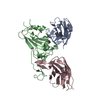
|
|---|---|
| 1 |
|
- Components
Components
| #1: Protein | Mass: 152312.750 Da / Num. of mol.: 1 Source method: isolated from a genetically manipulated source Source: (gene. exp.)  Gene: S, 2 / Production host:  Homo sapiens (human) / References: UniProt: P0DTC2 Homo sapiens (human) / References: UniProt: P0DTC2 |
|---|---|
| #2: Antibody | Mass: 14106.564 Da / Num. of mol.: 1 Source method: isolated from a genetically manipulated source Source: (gene. exp.)   |
| #3: Antibody | Mass: 13537.003 Da / Num. of mol.: 1 Source method: isolated from a genetically manipulated source Source: (gene. exp.)   |
| Has protein modification | Y |
-Experimental details
-Experiment
| Experiment | Method: ELECTRON MICROSCOPY |
|---|---|
| EM experiment | Aggregation state: PARTICLE / 3D reconstruction method: single particle reconstruction |
- Sample preparation
Sample preparation
| Component |
| ||||||||||||||||||||||||
|---|---|---|---|---|---|---|---|---|---|---|---|---|---|---|---|---|---|---|---|---|---|---|---|---|---|
| Molecular weight | Experimental value: NO | ||||||||||||||||||||||||
| Source (natural) |
| ||||||||||||||||||||||||
| Buffer solution | pH: 7 | ||||||||||||||||||||||||
| Specimen | Embedding applied: NO / Shadowing applied: NO / Staining applied: NO / Vitrification applied: YES | ||||||||||||||||||||||||
| Specimen support | Grid material: COPPER / Grid mesh size: 300 divisions/in. / Grid type: Quantifoil R1.2/1.3 | ||||||||||||||||||||||||
| Vitrification | Cryogen name: ETHANE |
- Electron microscopy imaging
Electron microscopy imaging
| Experimental equipment |  Model: Titan Krios / Image courtesy: FEI Company |
|---|---|
| Microscopy | Model: FEI TITAN KRIOS |
| Electron gun | Electron source:  FIELD EMISSION GUN / Accelerating voltage: 300 kV / Illumination mode: FLOOD BEAM FIELD EMISSION GUN / Accelerating voltage: 300 kV / Illumination mode: FLOOD BEAM |
| Electron lens | Mode: BRIGHT FIELD |
| Image recording | Electron dose: 55.9 e/Å2 / Detector mode: COUNTING / Film or detector model: GATAN K2 SUMMIT (4k x 4k) |
- Processing
Processing
| CTF correction | Type: PHASE FLIPPING AND AMPLITUDE CORRECTION |
|---|---|
| 3D reconstruction | Resolution: 3.44 Å / Resolution method: FSC 0.143 CUT-OFF / Num. of particles: 151630 / Symmetry type: POINT |
 Movie
Movie Controller
Controller




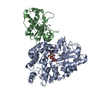
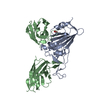
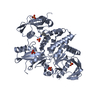
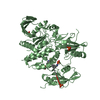
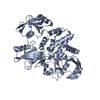
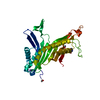
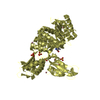
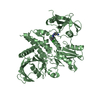
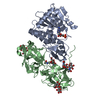
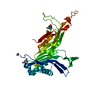
 PDBj
PDBj




